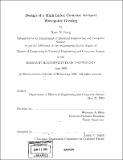| dc.contributor.advisor | Hermann A. Haus. | en_US |
| dc.contributor.author | Lang, Ryan N. (Ryan Nathan) | en_US |
| dc.contributor.other | Massachusetts Institute of Technology. Dept. of Electrical Engineering and Computer Science. | en_US |
| dc.date.accessioned | 2006-03-29T18:33:27Z | |
| dc.date.available | 2006-03-29T18:33:27Z | |
| dc.date.copyright | 2003 | en_US |
| dc.date.issued | 2003 | en_US |
| dc.identifier.uri | http://hdl.handle.net/1721.1/32314 | |
| dc.description | Thesis (M. Eng.)--Massachusetts Institute of Technology, Dept. of Electrical Engineering and Computer Science; and, (S.B.)--Massachusetts Institute of Technology, Dept. of Physics, 2003. | en_US |
| dc.description | S.B. and S.M. theses issued separately. | en_US |
| dc.description | Includes bibliographical references (p. 115-119). | en_US |
| dc.description.abstract | Arrayed waveguide gratings (AWGs) are useful structures for the implementation of wavelength division multiplexing. The AWG consists of an input splitter, a dispersive waveguide array which creates the wavelength demultiplexing and multiplexing effects, and an output coupler. Because the dispersive waveguide array consists of bent waveguides, the size of an AWG is limited by the light loss in the bends. In their current form, silica-based gratings are too large to be made cheaply or to use as an integrated component. The proposed solution is to redesign the AWG using high index contrast materials for tight confinement of the waveguide modes and, consequently, low bend loss. A rough design is presented for a high index contrast AWG using multimode interference couplers as the coupling stages. The major components were simulated using finite difference time domain (FDTD) techniques to find low loss but rather high crosstalk. A second possible design is also presented, making use of a coupled waveguide array as the input element. The coupling coefficients of as many as 41 coupled waveguides were adjusted to create a Gaussian profile as an input to the dispersive section of the AWG. The output coupler, however, will make use of more standard free space diffraction techniques, making the overall concept a unique mixture of waveguide and free space optical elements. | en_US |
| dc.description.statementofresponsibility | by Ryan N. Lang. | en_US |
| dc.format.extent | 119 p. | en_US |
| dc.format.extent | 5598191 bytes | |
| dc.format.extent | 5605468 bytes | |
| dc.format.mimetype | application/pdf | |
| dc.format.mimetype | application/pdf | |
| dc.language.iso | eng | en_US |
| dc.publisher | Massachusetts Institute of Technology | en_US |
| dc.rights | M.I.T. theses are protected by copyright. They may be viewed from this source for any purpose, but reproduction or distribution in any format is prohibited without written permission. See provided URL for inquiries about permission. | en_US |
| dc.rights.uri | http://dspace.mit.edu/handle/1721.1/7582 | |
| dc.subject | Physics. | en_US |
| dc.subject | Electrical Engineering and Computer Science. | en_US |
| dc.title | Design of a high index contrast arrayed waveguide grating | en_US |
| dc.type | Thesis | en_US |
| dc.description.degree | S.B. | en_US |
| dc.description.degree | M.Eng. | en_US |
| dc.contributor.department | Massachusetts Institute of Technology. Department of Electrical Engineering and Computer Science | |
| dc.contributor.department | Massachusetts Institute of Technology. Department of Physics | |
| dc.identifier.oclc | 61357167 | en_US |
